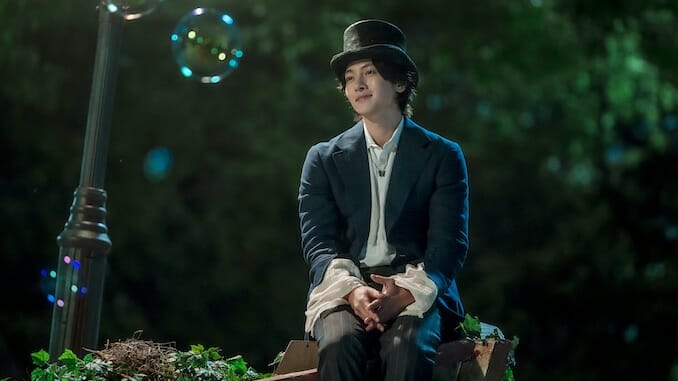The Sound of Magic: Netflix’s Fantastical, Musical K-Drama Lacks Narrative Harmony
Photo Courtesy of Netflix
The Sound of Magic, like many K-dramas and other international fare, is not quite like anything on American TV—though it may bring some wildly dissimilar western media references to mind. Simultaneously reminiscent of musical spectacle film The Greatest Showman and an episode of crime procedural CSI, the six-part, coming-of-age Netflix drama follows Seoul teens Yoon Ah-yi (Choi Sung-eun) and Na Il-deung (Hwang In-youp) in the weeks following their meeting an eccentric local magician named Ri-eul (Ji Chang-wook). Ah-yi and Il-deung find an escape from the pressures of their lives when they visit Ri-eul’s home in an abandoned theme park to learn magic, but when a string of violent attacks threatens the community, they must determine for themselves if Ri-eul is behind them. Also, there is singing.
The Sound of Magic is adapted from a black-and-white webtoon called Annarasumanara (used here similarly to “abracadabra”), and has been billed as a fantasy musical series in much of its marketing. But viewers heading into the series expecting a primarily genre-driven story may be disappointed. The series is uneven in its commitment to both the musical format and the fantasy genre, burning through most of its effervescent, could-be-real-magic musical numbers in the first half of its run before getting distracted by a superfluous, sensational crime drama involving a missing teen. Because of the relatively short episode order (Korean drama usually run for at least 16 episodes), the series stretches itself too thin to succeed fully in most of its many narrative ambitions, but it comes the closest in its exploration of its coming-of-age themes, as protagonists Ah-yi and Il-deung both grapple with the question of what kind of person they hope to grow into in a veritable wasteland of positive adult role models.
The Sound of Magic may be uneven but, when it’s good, it’s wonderful, especially in its musical (and not) articulation of the anxieties and hopes at the cores of Ah-yi and Il-deung’s characters. The two are very different in their struggles, but share a frustration with the adults in their lives, who fail them in a variety of ways. For Ah-yi, who has been abandoned by both parents and left to raise her younger sister while she herself is still a child, the failures are perhaps a bit more obvious to American viewers. While most of her peers are worried about their next test score, Ah-yi is worried about finding enough money to buy food for dinner. She is quite clearly living in poverty, but none of the adults in her life care enough to notice, let alone do anything to help. Rather, they are depicted as being more interested in catering to any whisper of a whim from Ah-yi’s privileged classmates and their parents.
Compared to Ah-yi, Il-deung seemingly has it all. His parents are not only present, but actively involved in his life, able and willing to buy him an iPad at the mere suggestion that it might be helpful in his studies. Il-deung’s mother is always ready with snacks or to drive him to his hagwon, the private tutoring academies that represent a more than $15 billion industry in Korea. And the teachers in his life bend over backwards in order to support him. However, it soon becomes clear that, while Ah-yi’s parents may be absent, Il-deung’s parents are too present, micromanaging every one of his choices in an attempt to maximize his test scores and guarantee a future on par with his father’s economic and social success. Il-deung is working himself to the bone for his parents’ dream, and becomes increasingly unsure if it is worth it. When he shares these concerns with his parents, they tell him to keep studying.
Rather than illegitimizing Il-deung’s worries in comparison to Ah-yi’s struggle to meet her basic needs, the former’s anxieties are treated with the seriousness they warrant in a country where suicide has been the leading cause of death among young people since 2007. According to a 2021 poll conducted by Korea’s National Youth Policy Institute, one in three middle and high school students in Seoul have thought of suicide, with the leading reasons being academic stress and worries over their futures and careers. Il-deung represents the not-small portion of Korean youth who are crying out (or too often staying silent) under the weight of the social and economic pressures of a country with wealth inequality only slightly better than conditions here in the U.S. It is an issue that is regularly explored in K-content, including in Netflix’s other recent webtoon adaptation, zombie drama All of Us Are Dead, and that can offer a cross-cultural catharsis for American viewers looking for more genre-driven explorations of socioeconomic pressures in our their storytelling.